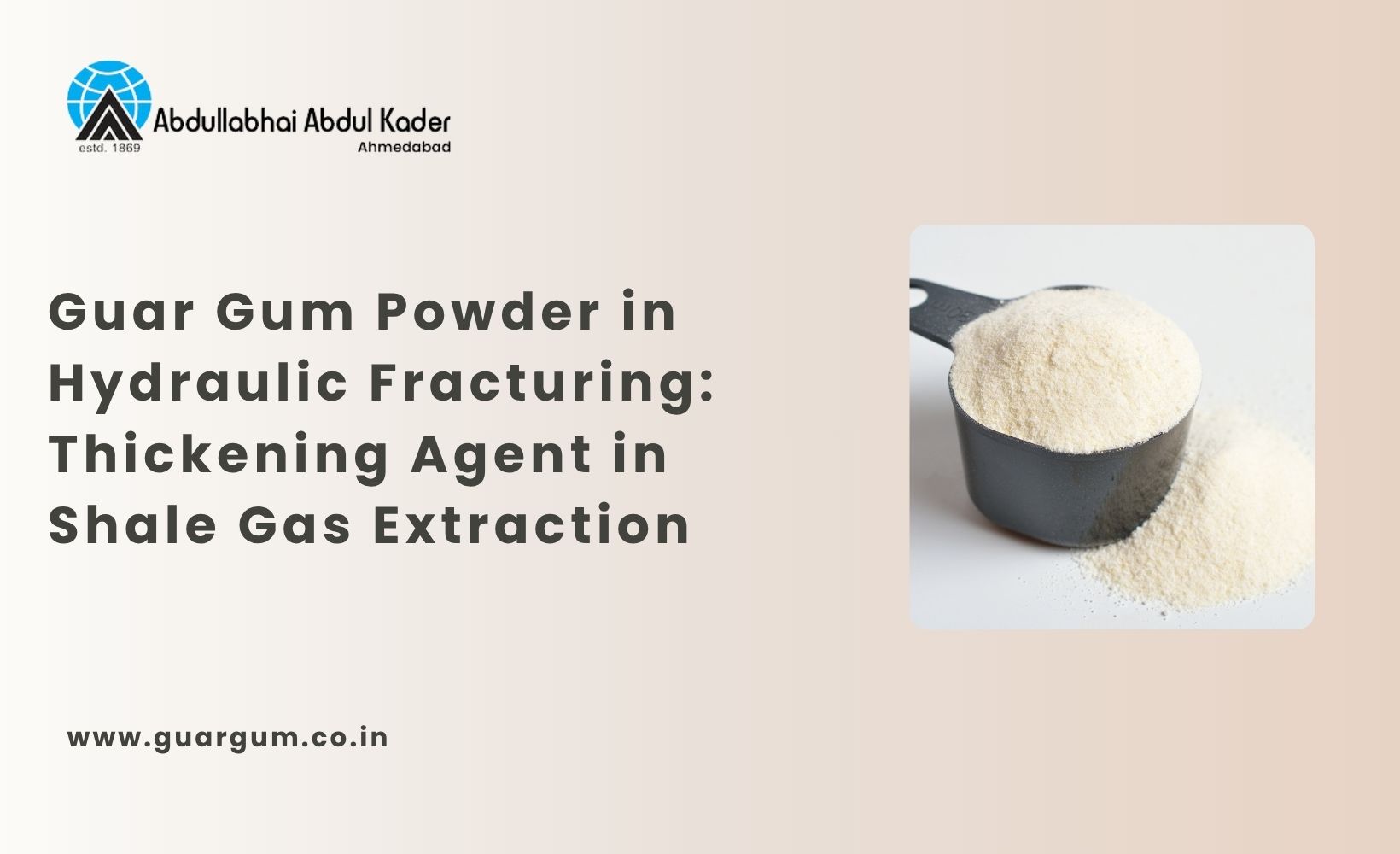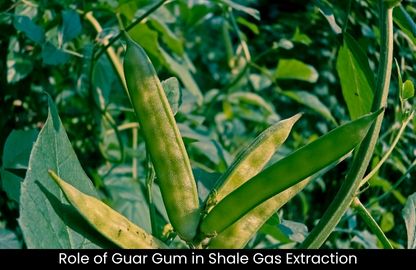
Objective:
This article delves into the critical role of guar gum powder as a thickening agent in hydraulic fracturing, specifically for shale gas extraction. With the increasing demand for energy and the continuous expansion of the oil and gas industry, the use of guar gum in hydraulic fracturing provides a sustainable and effective solution to enhance the extraction process. This article explores the application of guar gum powder in hydraulic fracturing, its functions and its importance in the shale gas extraction process.
Introduction
Hydraulic fracturing or fracking, is a well-established method used in the oil and gas industry to extract oil and natural gas from shale rock formations. One of the key components in this process is the use of thickening agents in the fracking fluid. Guar gum powder, a natural polysaccharide derived from the seeds of the guar plant, is one of the most commonly used thickening agents in hydraulic fracturing due to its effectiveness, availability and cost-efficiency.
As the energy sector looks to increase production and reduce environmental impact, guar gum powder has become an essential ingredient in shale gas extraction. Its ability to improve the flow properties of fracking fluid ensures that the process is both efficient and effective in breaking up the shale formations and allowing the release of trapped hydrocarbons.
Why is Guar Gum Powder Used as a Thickening Agent in Hydraulic Fracturing?
Hydraulic fracturing relies heavily on the ability to maintain a high viscosity in the fracking fluid to transport proppants efficiently. Guar gum powder plays a crucial role in this process due to the following reasons:
- High Viscosity at Low Concentrations: Guar gum powder can achieve a high viscosity at low concentrations, making it a cost-effective option for fracking fluid. Even small amounts of guar gum can significantly improve the fluid’s flow properties, reducing the need for additional chemicals and materials.
- Effective Proppant Transport: The increased viscosity of guar gum enables the fracking fluid to carry proppants deep into the fractures in the shale rock. This ensures that the fractures remain open after the fluid is injected, allowing for the continued flow of oil and gas.
- Cost-Effective and Readily Available: Guar gum is abundant and relatively inexpensive, especially compared to synthetic alternatives. Its cost-effectiveness makes it a preferred choice in hydraulic fracturing operations worldwide, particularly in large-scale projects.
- Environmental Considerations: Compared to synthetic polymers, guar gum is a natural, biodegradable substance. This makes it an attractive option for companies looking to minimize the environmental impact of hydraulic fracturing operations. Although fracking still has environmental concerns, the use of a natural product like guar gum reduces the amount of non-biodegradable waste.
How Does Guar Gum Powder Contribute to Shale Gas Extraction?
Shale gas extraction involves the process of injecting a pressurized fluid into deep underground rock formations to create fractures and release trapped gas. Guar gum powder contributes to this process in several ways:
- Improved Fluid Mobility and Control: The thickened fluid provides better control over the flow rate during the fracturing process, ensuring that the fluid is injected at the correct pressure. This control helps prevent the risk of over-pressurizing the formation, which could lead to well blowouts or other safety hazards.
- Enhanced Fracture Propagation: Guar gum as thickening agent, allow the fracturing fluid to flow more effectively through the rock, creating wider and more extensive fractures. These fractures are essential for maximizing the volume of oil or gas that can be extracted from the formation.
- Reduced Water Usage: Because guar gum thickens the fluid, it reduces the amount of water needed for the fracturing process. This reduction in water use is particularly beneficial in areas where water is a scarce resource, helping to conserve this valuable commodity while maintaining the efficiency of the extraction process.
- Better Well Productivity: The increased viscosity and improved proppant transport properties that guar gum powder provides contribute to better well productivity. With enhanced fracture conductivity, more oil and gas can flow from the formation, increasing the output of each well.

What Are the Key Applications of Guar Gum Powder in Hydraulic Fracturing?
Guar gum powder is widely used in the hydraulic fracturing industry, with several key applications that ensure the success of the extraction process:
- Thickening Agent in Fracking Fluids: The primary application of guar gum powder in hydraulic fracturing is as a thickening agent in fracking fluids. Its ability to enhance the viscosity of the fluid allows it to transport proppants efficiently and create deeper fractures in shale formations.
- Well Stimulation: Guar gum is also used in well stimulation processes to enhance oil and gas recovery. By improving the flow properties of the fluid, it ensures that the fractures in the shale rock remain open, allowing for better flow of oil and gas to the surface.
- Production Enhancement: In addition to its role in fracturing, guar gum is also used to enhance the productivity of existing wells. By improving the flow rate and reducing fluid loss, guar gum can help optimize well performance over time.
What Are the Challenges and Limitations of Using Guar Gum Powder in Hydraulic Fracturing?
Despite its effectiveness, the use of guar gum in hydraulic fracturing is not without challenges. Some of the key issues include:
- Hydrolysis and Degradation: Guar gum can degrade when exposed to high temperatures and extreme pH levels, which can reduce its thickening ability. This is particularly problematic in deep shale formations where the temperature and pressure are high. To combat this, additives may be mixed with guar gum to improve its stability in such conditions.
- Supply and Price Volatility: The price of guar gum is subject to fluctuations due to factors like crop yields and global demand. This can lead to price volatility, which affects the cost of hydraulic fracturing operations. In times of high demand, the supply of guar gum may also be constrained, leading to supply chain issues.
- Environmental Impact: While guar gum is biodegradable, the overall environmental impact of hydraulic fracturing remains a concern. The use of large quantities of water and the potential for contamination of water sources are major environmental challenges that still need to be addressed.
Conclusion
Guar gum powder plays an indispensable role in hydraulic fracturing, particularly in shale gas extraction. Its ability to thicken fracking fluids, improve proppant transport and reduce water usage makes it a vital ingredient in the oil and gas industry. While challenges such as supply volatility and degradation under extreme conditions remain, the benefits of guar gum as a cost-effective, natural thickening agent are clear.
As the demand for energy continues to rise, guar gum’s application in hydraulic fracturing will likely expand, contributing to more efficient and sustainable shale gas extraction. With ongoing advancements in technology and techniques, guar gum will continue to play a key role in shaping the future of the oil and gas industry.



